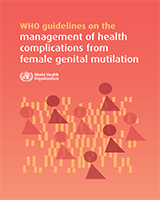These guidelines are intended primarily for health-care professionals involved in the care of girls and women who have been subjected to any form of female genital mutilation (FGM). This document also provides guidance for policy-makers, health-care managers and others in charge of planning, developing and implementing national and local health-care protocols and policies. The information contained in this document will also be useful for designing job aids and pre- and in-service professional training curricula in the areas of medicine, nursing, midwifery and public health for health-care providers caring for girls and women living with FGM.
The designations employed and the presentation of the material in this publication do not imply the expression of any opinion whatsoever on the part of the World Health Organization concerning the legal status of any country, territory, city or area or of its authorities, or concerning the delimitation of its frontiers or boundaries. Dotted and dashed lines on maps represent approximate border lines for which there may not yet be full agreement.
The mention of specific companies or of certain manufacturers' products does not imply that they are endorsed or recommended by the World Health Organization in preference to others of a similar nature that are not mentioned. Errors and omissions excepted, the names of proprietary products are distinguished by initial capital letters.
All reasonable precautions have been taken by the World Health Organization to verify the information contained in this publication. However, the published material is being distributed without warranty of any kind, either expressed or implied. The responsibility for the interpretation and use of the material lies with the reader. In no event shall the World Health Organization be liable for damages arising from its use.

